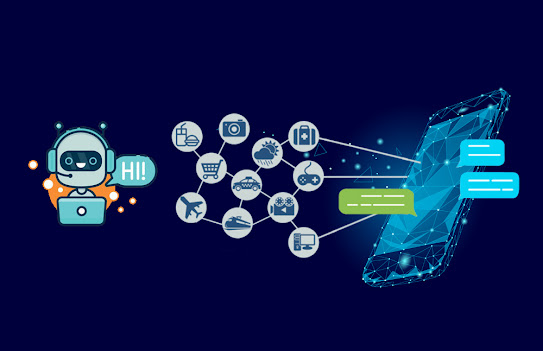Chat AI Latest
Chat AI
Chat AI, also known as conversational AI, refers to a branch of artificial intelligence (AI) that focuses on creating software programs and systems capable of engaging in human-like conversations with users. These AI systems are designed to understand natural language input, process it, and generate coherent and contextually relevant responses.
Key characteristics and aspects of Chat AI include:
1. Natural Language Processing (NLP): Chat AI systems are built on NLP technology, which enables them to understand and interpret human language in both written and spoken forms. NLP algorithms analyze text or speech to extract meaning, identify entities, and understand the intent behind the user's input.
2. Dialogue Management: Effective Chat AI systems manage conversations like humans do, maintaining context, tracking user queries, and providing appropriate responses. They use dialogue management techniques to ensure coherent and context-aware interactions.
3. Machine Learning: Many Chat AI systems leverage machine learning algorithms to improve their performance over time. They learn from user interactions and data to enhance their language comprehension and response generation capabilities.
4. Use Cases: Chat AI finds applications across various domains, including customer support (chatbots), virtual assistants (like Siri or Alexa), healthcare (diagnosis and patient interaction), education (tutoring and language learning), and more. It can also be used for automating tasks and providing information in a conversational manner.
5. User Experience: The user experience is a critical aspect of Chat AI. These systems aim to provide a seamless and user-friendly interaction, ensuring that users feel comfortable and understood during the conversation.
6. Multimodal Capabilities: Some Chat AI systems incorporate multiple modes of communication, such as text, speech, and even visual elements, to enhance their versatility and usefulness.
7. Challenges: Chat AI faces challenges such as understanding context, handling ambiguous queries, and addressing ethical concerns related to privacy, bias, and the responsible use of AI.
8. Integration: Chat AI systems can be integrated into various platforms and applications, including websites, mobile apps, messaging services, and more, to provide real-time assistance and enhance user engagement.
9. Future Trends: The field of Chat AI is continuously evolving. Future trends may include more advanced AI models, improved personalization, enhanced emotional intelligence, and better support for multiple languages and dialects.
Chat AI has made significant strides in recent years, and it continues to shape how we interact with technology and access information. As technology advances and AI models become more sophisticated, we can expect even more natural and context-aware conversations with Chat AI systems, making them increasingly valuable in various aspects of our daily lives. However, it's essential to address ethical considerations and ensure responsible development and deployment to harness the full potential of this technology while minimizing risks.
Chat AI, like any technology, comes with its own set of advantages and disadvantages. Understanding these can help us make informed decisions about when and how to use chat AI systems. Here are some of the key advantages and disadvantages:
**Advantages of Chat AI:**
1. **24/7 Availability:** Chat AI systems can provide round-the-clock support, enhancing accessibility for users who may need assistance at any time.
2. **Cost-Efficiency:** Implementing chat AI can be cost-effective compared to human customer support or assistance, as it reduces the need for extensive human staffing.
3. **Scalability:** Chat AI can handle a large volume of interactions simultaneously, making it scalable to meet growing user demands.
4. **Consistency:** Chat AI provides consistent responses and adheres to predefined guidelines, reducing the risk of errors or variations in information provided.
5. **Quick Response Times:** Chat AI can respond to user inquiries instantly, reducing wait times and improving user satisfaction.
6. **Multilingual Support:** Chat AI can be programmed to support multiple languages, making it accessible to a global audience.
7. **Data Collection and Analysis:** Chat AI systems can gather valuable data on user interactions, preferences, and pain points, which can inform decision-making and product/service improvements.
8. **Automation of Routine Tasks:** Chat AI can handle repetitive and routine tasks, freeing up human agents to focus on more complex and value-added activities.
9. **Personalization:** Chat AI can use data to provide personalized recommendations and responses, enhancing the user experience.
**Disadvantages of Chat AI:**
1. **Lack of Empathy:** Chat AI lacks human emotions and empathy, making it less suitable for sensitive or emotionally charged interactions.
2. **Limited Understanding:** Chat AI may struggle to understand complex or nuanced queries, leading to frustration for users seeking detailed information or assistance.
3. **Language and Cultural Bias:** Chat AI systems can inadvertently reflect biases present in the data they were trained on, potentially leading to unfair or biased responses.
4. **Privacy Concerns:** Users may have concerns about the privacy of their data when interacting with chat AI systems, particularly if sensitive information is shared.
5. **Initial Setup Complexity:** Developing and implementing chat AI systems can be complex and require significant upfront investment in terms of time, resources, and expertise.
6. **Maintenance and Updates:** Chat AI systems require ongoing maintenance, updates, and training to stay relevant and effective.
7. **Lack of Creativity:** Chat AI systems are limited by their programming and may struggle with creative problem-solving or thinking outside predefined parameters.
8. **Misunderstanding Context:** Chat AI can sometimes misinterpret context or user intent, leading to irrelevant or incorrect responses.
9. **Depersonalization:** Overreliance on chat AI can lead to a depersonalized user experience, where human interaction is minimized, potentially reducing customer satisfaction in certain situations.
It's essential to recognize that the advantages and disadvantages of chat AI can vary depending on the specific implementation and use case. Therefore, businesses and organizations must carefully assess their needs and objectives before deciding whether to integrate chat AI into their operations. Additionally, continuous monitoring, fine-tuning, and ethical considerations are essential when using chat AI to ensure that it aligns with user expectations and business goals while mitigating potential drawbacks.


-min.jpeg)
Comments
Post a Comment